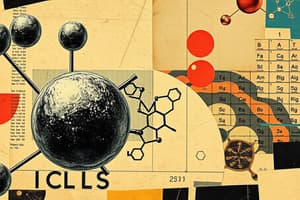Podcast
Questions and Answers
¿Qué parte de un átomo determina su identidad elemental?
¿Qué parte de un átomo determina su identidad elemental?
- Electrones
- Protones (correct)
- Neutrones
- Núcleo
¿Qué tipo de enlace químico se forma cuando los átomos comparten electrones?
¿Qué tipo de enlace químico se forma cuando los átomos comparten electrones?
- Enlace covalente (correct)
- Enlace de hidrógeno
- Enlace metálico
- Enlace iónico
¿Qué tipo de reacción química libera o absorbe energía?
¿Qué tipo de reacción química libera o absorbe energía?
- Reacción de combustión (correct)
- Reacción de síntesis
- Reacción de sustitución simple
- Reacción de descomposición
¿Qué representan los números que figuran en la tabla periódica?
¿Qué representan los números que figuran en la tabla periódica?
¿Qué tipo de enlace químico se forma cuando hay transferencia de electrones entre átomos?
¿Qué tipo de enlace químico se forma cuando hay transferencia de electrones entre átomos?
¿En qué tipo de reacción química se combinan dos sustancias para formar una nueva?
¿En qué tipo de reacción química se combinan dos sustancias para formar una nueva?
¿En qué se basa la tabla periódica para organizar los elementos químicos?
¿En qué se basa la tabla periódica para organizar los elementos químicos?
¿Qué principio es esencial para entender las reacciones químicas?
¿Qué principio es esencial para entender las reacciones químicas?
¿Cuál es el objetivo principal de la química mencionado en el texto?
¿Cuál es el objetivo principal de la química mencionado en el texto?
¿Qué propiedad se utiliza para organizar los elementos en la tabla periódica?
¿Qué propiedad se utiliza para organizar los elementos en la tabla periódica?
¿Qué nos permite profundizar nuestra apreciación por la complejidad de la química, según el texto?
¿Qué nos permite profundizar nuestra apreciación por la complejidad de la química, según el texto?
¿Qué ley establece que la cantidad de masa en una reacción química permanece constante?
¿Qué ley establece que la cantidad de masa en una reacción química permanece constante?
Study Notes
Exploring the World of Chemistry
Chemistry is a vibrant and dynamic subject that investigates the composition, behavior, and interactions of matter at the most fundamental level. To understand this vast realm, let's delve into the fundamentals: atoms, molecules, chemical reactions, and the periodic table.
Atoms
Atoms are the building blocks of all matter. They are the smallest unit of an element that retains the element's properties. Each atom has a central nucleus, composed of protons and neutrons, surrounded by a cloud of electrons. The protons are positively charged, while the neutrons are electrically neutral. The electrons, which are negatively charged, orbit the nucleus. The number of protons in an atom determines its elemental identity and is called the atomic number.
Molecules
Molecules are formed when atoms bond together to form a chemical compound. There are two types of chemical bonds: covalent bonds and ionic bonds. Covalent bonds form when atoms share electrons, while ionic bonds form when electrons are transferred between atoms. Molecules are made up of multiple atoms, and their properties differ from the properties of the individual atoms.
Chemical Reactions
Chemical reactions occur when molecules interact and form new substances, releasing or absorbing energy. These reactions can be classified as synthesis (combination), decomposition, single replacement (displacement), double replacement (metathesis), and combustion reactions. The law of conservation of mass and the stoichiometry of the reaction are essential to understanding chemical reactions.
Periodic Table
The periodic table is an essential tool for organizing and understanding the properties of the chemical elements. Developed by Dmitri Mendeleev in the 19th century, the periodic table arranges the elements based on their atomic number, which is the number of protons in their nucleus. The periodic table is organized into periods and groups, which help to identify trends in atomic properties.
In conclusion, chemistry provides us with the opportunity to explore the fundamental principles of matter, analyze the interactions between atoms and molecules, and design new materials and processes to advance our world. By understanding the basics of atoms, molecules, chemical reactions, and the periodic table, we can deepen our appreciation for the complexities and vastness of chemistry.
As you continue to delve into this fascinating subject, remember that there is always more to learn, uncover, and discover. Happy exploring!
Studying That Suits You
Use AI to generate personalized quizzes and flashcards to suit your learning preferences.
Description
Explore the fundamental concepts of chemistry including atoms, molecules, chemical reactions, and the periodic table. Learn about the composition of matter, types of bonds, classification of reactions, and organization of elements. Delve into the complexities of chemistry to deepen your understanding of the world.



